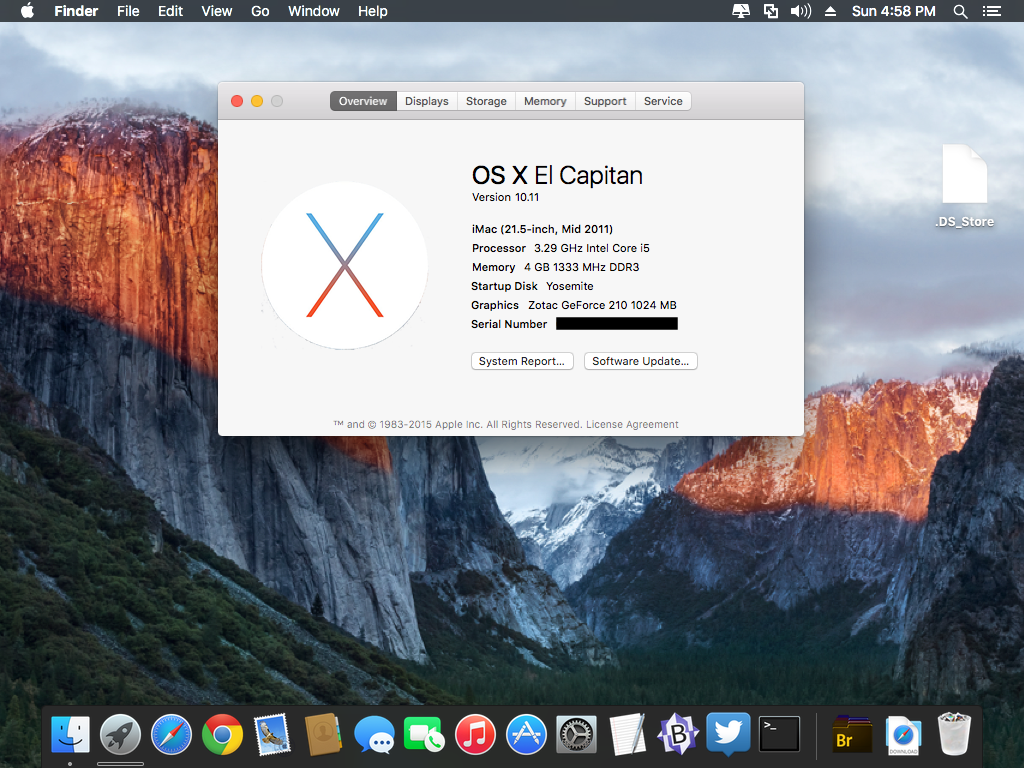To get the latest features and maintain the security, stability, compatibility, and performance of your Mac, it's important to keep your software up to date. Apple recommends that you always use the latest macOS that is compatible with your Mac.
Do you want OS X 10:11 El Capitan faster than you can use the OS X Terminal Commands 10 below. The commands disable various delays from that standard built by Apple. Open OS X Terminal, which you can find in the folder: Applications Utilities. Copy and paste the following command either in the Terminal window. OS X user interface. The latest software makes your Mac device compatible with the new technological developments. Still, it also makes the existing OS obsolete. That's why most Mac users with old devices try to update their Mac to OS X El Capitan. However, you can't update your Mac to El Capitan 10.11 if your Mac runs on software later than Mac OS X 10.6 Snow Leopard. Bash Profile Configuration. The profile file is run during boot-up to configure the terminal to define file path, shims, and autocompletion handlers. This is the single biggest frustration with people using Linux on Mac. One of the earliest articles on bash here shows shell variables, environment variables, and aliases. Each operating system has its own file name for its profile. Just upgraded to El Capitain 10.11.1 (wotta nightmare). My biggest beef if the calendar icon on the dock previously (10.7.5) clearly and boldly showed the date. With this new font, the numbers are thin and reedy and if you have minimized a bunch of stuff the icon gets so small the numbers become illegible. Any way to get the previous calendar back?
Change Date Terminal Mac El Capitan Update
Learn how to upgrade to macOS Big Sur, the latest version of macOS.
Check compatibility
The version of macOS that came with your Mac is the earliest version it can use. For example, if your Mac came with macOS Big Sur, it will not accept installation of macOS Catalina or earlier.
If a macOS can't be used on your Mac, the App Store or installer will let you know. For example, it might say that it's not compatible with this device or is too old to be opened on this version of macOS. To confirm compatibility before downloading, check the minimum hardware requirements:
- macOS Catalina 10.15 hardware requirements
- macOS Mojave 10.14 hardware requirements
- macOS High Sierra 10.13 hardware requirements
- macOS Sierra 10.12 hardware requirements
- OS X El Capitan 10.11 hardware requirements
- OS X Yosemite 10.10 hardware requirements
Download macOS using Safari on your Mac
Safari uses these links to find the old installers in the App Store. After downloading from the App Store, the installer opens automatically.
- macOS Catalina 10.15 can upgrade Mojave, High Sierra, Sierra, El Capitan, Yosemite, Mavericks
- macOS Mojave 10.14 can upgrade High Sierra, Sierra, El Capitan, Yosemite, Mavericks, Mountain Lion
- macOS High Sierra 10.13 can upgrade Sierra, El Capitan, Yosemite, Mavericks, Mountain Lion
Safari downloads the following older installers as a disk image named InstallOS.dmg or InstallMacOSX.dmg. Open the disk image, then open the .pkg installer inside the disk image. It installs an app named Install [Version Name]. Open that app from your Applications folder to begin installing the operating system.
- macOS Sierra 10.12 can upgrade El Capitan, Yosemite, Mavericks, Mountain Lion, or Lion
- OS X El Capitan 10.11 can upgrade Yosemite, Mavericks, Mountain Lion, Lion, or Snow Leopard
- OS X Yosemite 10.10can upgrade Mavericks, Mountain Lion, Lion, or Snow Leopard
Why do you need to download El Capitan through Terminal.
El Capitan is freely available from this link.
Here are the instructions.
Go to Section 4 and click on Download OS X El Capitan.
This downloads InstallMacOSX.dmg to your Downloads folder.

The next section can only be done on a mac that is capable of running El Capitan,
a mac that came preinstalled with an OS later than El Capitan will refuse to do the next bit.
When downloaded open to InstallMacOSX.pkg, double-click on
Mac Os X El Capitan
that and an installation window will open, this does not install El Capitan

but converts the InstallMacOSX.pkg to the Install OS X El Capitan.app which
you will find in your Applications folder, it should be 6.2GBs in size.
(If the installation window asks which disk you want to install to, you must pick
the disk that you are booted to at the time. Not any internal or external disk that
you want to eventually install El Capitan on, that is for later.)
To start the installation of El Capitan double click on the Install OS X El Capitan.app.
The copy of the install app self deletes after installing El Capitan, so make sure you keep a copy of the InstallMacOSX.dmg
if you need it in future, or you could just make a copy of the Install OS X El Capitan.app prior to installing and moving it to
an external drive for safe keeping. It is also possible to create a bootable USB installer disk using the Install OS X El Capitan.app
in the Applications folder and the createinstallmedia command in the Terminal app.
Read the instructions here,
El Capitan Apple
Sep 2, 2020 12:18 AM
Comments are closed.